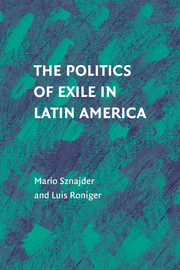Book contents
- Frontmatter
- Contents
- Acknowledgments
- List of Acronyms
- Introduction: The Politics of Exile
- 1 Defining the Exilic Condition
- 2 Forceful Displacement, the Construction of Collective Identities, and State Formation
- 3 The Format of Early Exile
- 4 Sites of Exile
- 5 Widening Exclusion and the Four-Tiered Structure of Exile
- 6 Exile Communities, Activism, and Politics
- 7 Presidents in Exile
- 8 Is Return the End of Exile?
- Bibliography
- Index
- References
5 - Widening Exclusion and the Four-Tiered Structure of Exile
Published online by Cambridge University Press: 28 July 2009
- Frontmatter
- Contents
- Acknowledgments
- List of Acronyms
- Introduction: The Politics of Exile
- 1 Defining the Exilic Condition
- 2 Forceful Displacement, the Construction of Collective Identities, and State Formation
- 3 The Format of Early Exile
- 4 Sites of Exile
- 5 Widening Exclusion and the Four-Tiered Structure of Exile
- 6 Exile Communities, Activism, and Politics
- 7 Presidents in Exile
- 8 Is Return the End of Exile?
- Bibliography
- Index
- References
Summary
In polities of restricted political participation, exile was mostly a privilege reserved for a segment of the political elite ostracized by those in power. By the late 19th and early 20th centuries, however, a process of ‘massification’ of exile was manifest, as growing numbers of exiles with a middle- or lower-class background were affected by their purposeful or unwilling involvement in politics and the public arena. Widening exclusion led to a dynamic of dispersion of exiles, allowing them to increasingly focus the attention of an evolving international public sphere, in which former themes of internal politics found an echo on the basis of growing awareness and care about human-rights violations, political persecution, and exile. The transformation of the early three-tiered structure of exile into a four-tiered structure constitutes the core of this chapter.
Massive Exile: The Counterface of Political Inclusion
This process of massification of exile occurred in tandem with the changing nature of the political and social conflicts in the region. Latin American countries underwent processes of population growth, modernization, migration, and urbanization at different paces. Within each of them, the uneven pace of transformations was replicated, shaping strong internal asymmetries. Still, beyond differences, the entire region was a scenario of changes in the 20th century: from traditional into modern lifestyles, from rural into urban settings, and from Catholicism into religiously diversified and, at times, secular frameworks. From both socioeconomic and political perspectives, these societies were transformed under the aegis of population growth, immigration, and internal migration.
- Type
- Chapter
- Information
- The Politics of Exile in Latin America , pp. 136 - 192Publisher: Cambridge University PressPrint publication year: 2009

